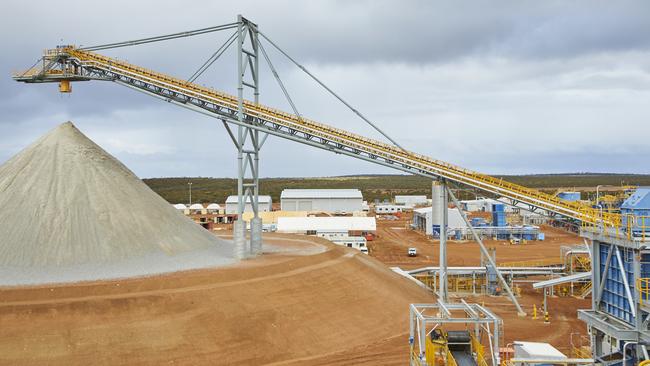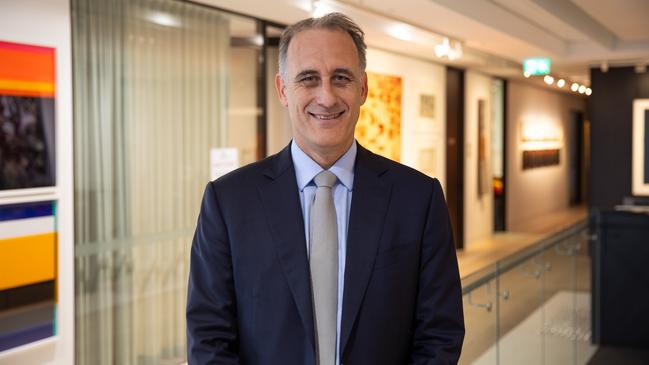Wesfarmers prepared to play the long game on lithium despite the mineral’s price tanking
Wesfarmers’ $900m-plus investment in the Covalent lithium mining and processing development of WA appears ill timed but observers say it’s shrewd and not a short-term prospect.

On a simplistic reading, Wesfarmers’ decision to go long on lithium, through its to-date almost $900m-plus investment in the Covalent mining and processing development in Western Australia, appears ill timed.
Lithium prices have crashed from their heady highs of late 2022, when they were four to five times what they are now, the stock prices of Australian producers and explorers have crashed, and once promising projects are being scaled back and even shelved.
But dig a little deeper, and read into the analyst reports, and it becomes clear that they are, as Jarden says, “playing a long game’’.
The Covalent Lithium project is a 50-50 joint venture between Wesfarmers, specifically its chemicals, energy and fertilisers arm WesCEF, and Chilean chemicals company Sociedad Química y Minera de Chile (SQM).
It involves a lithium mine and concentrator at Mt Holland, 400km due east of Perth and that was officially opened on Thursday, and a refinery at Kwinana, south of Perth, that will be capable of producing about 50,000 tonnes of lithium hydroxide a year following its completion, scheduled for later this year.
“In full production, Covalent Lithium will produce enough lithium hydroxide to enable approximately one million electric vehicles to replace regular vehicles on the road each year,’’ the joint venture says.

Lithium has had an interesting run in recent years. Its use as a key component in the batteries needed to power electric vehicles and store renewable energy has led to skyrocketing demand, users scrambling to lock down offtake deals, and an associated pricing surge.
BHP, for its part, decided to stay out of the race, with senior sources at the global miner of the opinion that, while there had been a mad scramble for the commodity, it was actually fairly common, with no projects of a size compelling enough for the mining giant to contemplate investing in.
But Wesfarmers and SQM are betting that the lithium story has a long way to run. By all accounts they’re not wrong – the key, as always, is in the pricing.
The Mt Holland mine and concentrator, on a brownfields site that was previously the Bounty Gold operation, is expected to have a mine life of about 50 years at the proposed production rate.
Covalent is looking to produce 380,000 tonnes of spodumene concentrate each year, with 100,000 tonnes a year by the middle of this calendar year, following the successful start-up and commissioning of the mine and concentrator, announced on Thursday.
Spodumene can be immediately sold, but the intent is to value-add through the joint venture’s refinery, being built in Kwinana. “Our refinery operations are expected to recover 75 per cent of the lithium contained in the spodumene concentrate,” the joint venture says.
“This high rate of recovery means we will be able to produce approximately 50,000 tonnes of battery-quality lithium hydroxide per year.”
Wesfarmers managing director Rob Scott, speaking at the launch of the Mt Holland operations on Thursday, said the lithium joint venture was a key growth project for the company.
“When we made our initial investment into Mt Holland four years ago, we saw an opportunity to enter the lithium market and leverage our expertise in chemical processing here in Western Australia,’’ Mr Scott said.
“It’s pleasing to see the successful commissioning and ongoing ramp-up of spodumene production.
“We are continuing to advance studies to expand the Mt Holland mine and concentrator, and the next key milestone for Covalent is completing construction of the Kwinana refinery, which remains on track for later in 2024.’’
In its earnings report just last month, Wesfarmers said the concentrator at Mt Holland was successfully commissioned during the first half of the financial year, “and operations recently entered the ramp-up phase, with first quality spodumene concentrate product available for sale in the first half of the 2024 calendar year’’.
“Offtake agreements with tier-one auto and battery customers have been agreed for sale of interim spodumene concentrate,” it said.
“Good progress continued on construction of the Kwinana refinery, which was approximately 65 per cent complete as at the end of the period.’’
WesCEF’s share of the capital expenditure, to the end of December, since the final investment decision, was $892m.
Analysts agree with the company’s optimism around the project. While Mt Holland is not expected to turn a profit this year, Jarden analysts say that, in the longer term, investors should not be concerned.
“Wesfarmers is playing a long game,’’ the broker says.
“However, we expect Mt Holland to be loss-making in FY24, with improving pricing and reaching scale key to driving improving profitability.’’
Jarden says it does expect slippage on costs, given there had been little disclosure outside of the original SQM technical report. “We assume higher costs than those disclosed, plus an increase in cost per tonne for (the second half of FY24 and all of FY25) relating to the ramp-up,’’ it says.
Citigroup analysts are forecasting “a small loss” for Covalent in the current year, but expect $55m in EBIT from spodumene sales in the 2025 fiscal year and $36m from lithium hydroxide.
With the refinery ramping up, Citi has forecast $462m in EBIT from lithium hydroxide in the 2027 fiscal year.
Should the integrated project succeed in its ambitions, it will be a major critical minerals achievement for the nation, given its usual predilection for exporting its resources wealth in an unrefined form.
Producers such as Core Lithium, with its shares trading at 22c, down from a year high of $1.20, or Liontown Resources, down from $3.19 in the heady days of the takeover tussle for the company to $1.295 now, know all too well the danger of being exposed to the vagaries of commodity prices.
Even the world’s largest lithium producer, Albemarle, in January said it would cut jobs and defer spending on a US refinery project in the face of sliding prices.
But the US company is still expecting a compound annual growth rate in demand for lithium carbonate or its equivalents of 15-20 per cent out to 2030, and 28 per cent year on year in 2024 alone.
Wesfarmers, Mr Scott says, intends to be well placed for when that forecast demand becomes a reality.


To join the conversation, please log in. Don't have an account? Register
Join the conversation, you are commenting as Logout